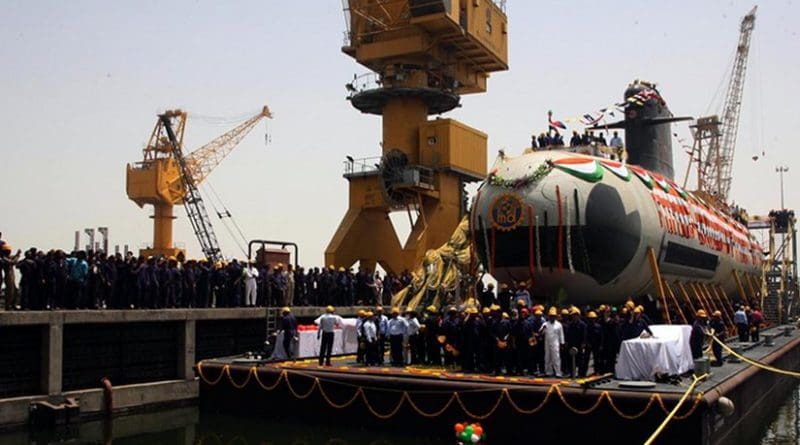India’s Naval Expansion Plans: Prospects For Pakistan – OpEd
India is industrializing her naval potency at rapid pace to accomplish the position of a “Blue Water Navy”. Nearly 90 percent of the Indian trade is carried out via sea route, which requires India to expand her resilient marine power in the Indian Ocean, securing maritime objectives and correspondingly establishing her hegemony in regional constituency and beyond.
The Indian Navy recently took delivery of the first domestically assembled long-range surface-to-air missile system (LRSAM) on August 27. The Barak-8 (first LRSAM) is indigenously produced by Indian missile maker Baharat Dynamic with the assistance of Indian MoD’, Defense Research and Development Organization (DRDOs) in collaboration with a production line setup by Israeli defense contractors IAI and its subsidiary Rafael in India. LRSAM is designed to deal with incoming airborne threats with a range of 90-150 kilometers and is equipped with advanced phased-array radar, command and control, mobile launchers and missiles with progressive radio frequency (RF) searchers.
However, India’s urge to advance blue water proficiencies is perceived as an intimidation by others in the neighborhood. It has particularly amplified Pakistan’s intentions, whose foremost security hazards hail from India. Moreover materializing the nuclear trio ambitions would provide India with a second-strike capability. Consequently the nuclear deterrence equation flanked by the hostile competitors will be disrupting.
According to an estimate as per data of 2016, the Indian Naval assets include 79,023 personnel and a large fleet comprising of 2 aircraft carriers, 1GAH amphibious transport dock, 9 landing ship tanks, 14 frigates, 10 destroyers, 1 nuclear powered submarine and 14 conventionally powered submarines, 25 corvettes, 7 minesweeping vessels, 47 patrol vessels, 4 fleet tankers, numerous auxiliary vessels, 8 maritime reconnaissance and anti-submarine aircraft purchased from Boeing Co. for $ 2.1 billion in 2009 and approved an order for 4 more aircraft.
India is repetitively refining and accumulating naval competences, her navel budget for the upcoming decade worth $61 billion in order to increase size of navy by half. Indigenously India not only lifted her vessels building capacity, but she has done fair enough collaboration as well. India plans to build a 160 plus-ship navy, three aircraft carrier battle groups, 40 warships and submarines including stealth destroyers, anti-submarine corvettes and stealth frigates, INS Vikrant due to be inducted by 2018-19, induction of MiG-29K multirole aircraft and Kamov-28 and 31 helicopters to position from its aircraft carriers as per 2022 plan. These acquisitions would immensely improve Indian reconnaissance capabilities and would provide the Indian Navy strategic outreach in the Indian Ocean.
According to the 2009 updated Indian Maritime Doctrine Indian Navy will put under her control all the choke points, significant islands, and trade routes, the Indian Ocean, Arabian Sea and in the Bay of Bengal. This vision is put forward for the Indian Navy by 2025. India aims to operationalize its naval force in combination with the United States. Taking benefit from US’s existence in the region India is trying to counter Chinese naval influence and advancing its own naval ambitions as well.
The more important point to ponder is that India set to nuclearize the Indian Ocean. This will deter other states of the region more especially Pakistan. Pakistan, intendeds to sustain an effective nuclear deterrent against India, the outline of the latter’s nuclear triplet is a hostile growth, intensifying the security dilemma between India and Pakistan. Indian naval nuclear advancement will qualitatively modify the strategic equilibrium amid India and Pakistan. It might provoke Pakistan enhance naval nuclear capability of her own for rebalancing the deterrence equation between the two. Subsequently this will hamper the strategic stability and geopolitical situation of the south Asian region thus leading to arms buildup and an arms race would start.
It is necessarily recommended for Pakistan to keep an eye on Indian naval transformation, thus by expanding her own indigenous defense manufacturing to meet the contemporary needs of the Pakistan Navy; because her flimsy economic sources does not let her to purchase new weapon systems from industrialized countries. Pakistan must boost her joint ventures with countries like China, Germany, and France to grow her nautical strength and overwhelmed her feebleness. Pakistan navy should also improve her exploration and reconnaissance proficiencies Pakistan Navy should invite countries and participate in joint navel exercises with other countries to enlarge her operative war fighting abilities at sea to overwhelmed upcoming intimidations and encounters to her national security.
*Qura tul ain Hafeez has done M Phil in international relations from Quaid-I Azam University Islamabad. she is currently working as a research associate at Strategic Vision Institute Islamabad .Her domain of work include China as an emerging global power, Sino-Pakistan strategic and civil nuclear relations, South Asian strategic issues, regional integration, nuclear issues including nuclear non-proliferation and NSG, Foreign Policy analysis, and international politics


There appears to be fundamental flaws in the thinking of the Author and may be by Pakistanis and their Government too. India is a much bigger country with much higher resources and seeking parity with it by Pakistan will end only in disappointment. And it has also to understand that for seeking the help of other countries and rejoicing over it will cost the country and it will have to necessarily pay a price because there is no free lunch in international relations. It has also to understand that the moment it abandons its unachievable objective of securing Kashmir from India, the threat perspective to it will vanish. The most beneficial action for the country will be to settle the boundary with India along the present LOC and live peacefully with all its neighbors which will ensure its rapid progress. Will they listen to reason? Krish